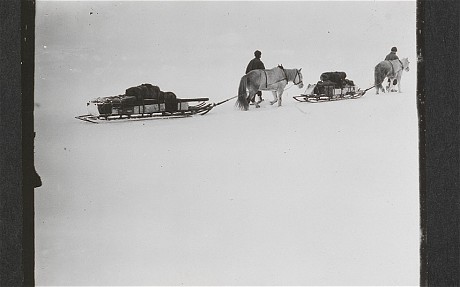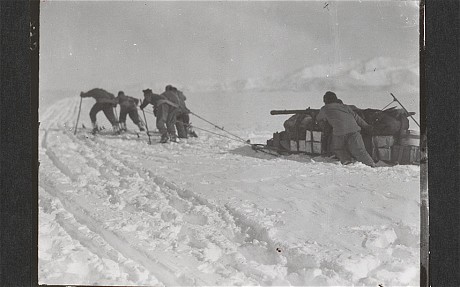Today’s offering is a blatant lift from my old muckers at her majesty’s The Daily Telegraph. These snaps, taken by the very greatest of Britons, should be saved for the country. It’s scandalous that we cannot raise a couple of quid to keep these in the UK.
Back in the day when I was working at the aforementioned DT all of these photos would have been binned and we’d have used whatever Reuters or The PA had. The picture Editor (no names, no pack-drill) would have given the photographer, R.F.Scott, a bollocking and asked “Is this the best you’ve got?” and asked why he didn’t manage to get a blonde bird in the frame. This was back in the late 80s and the early 90s, the birth of myopic photo-journalism. The Back Bench would have hidden them as a 2 column or a thumbnail on the basement of page 19, or “saved” them as a “Sunday for Monday” an old euphamism for never considering them again) .
YOUNG WOMAN WEARS DRESS would have been the front page headline accompanied by a young-ish woman on the red carpet of some awards ceremony wearing a…er…dress. It’s what passes for news nowadays and the DT was the pioneer of such thinking. And they called themselves a “quality” “broadsheet”. Honest. They probably still do. Whatever they’ll tell you now, they wouldn’t have used these polar pics properly, if at all (some of these butchers and know-nothings are still around and, staggeringly, gainfully employed today — see David Lucas on The Standard). So it’s rather amusing, ironic, even comforting to see the Telegraph come to the rescue of proper photography, years after having been its assailant. (I don’t sound too bitter do I ?)
Please forward this to that rich bloke you know and tell him to give generously. For my part, I am going through The Incumbent’s drawers in search of hidden treasures.
The Battle to Save Scott of the Antarctic’s Lost Pictures
Jasper Copping
The Daily Telegraph
Unseen images of Scott of the Antarctic’s doomed final expedition could be lost to the nation after their mystery owner gave Cambridge University until the end of the month to raise £275,000 to buy them.
If the funds are not in place by March 25, the photographic negatives are due to go for auction, where it is expected they will be purchased by a private collector from overseas.
The images were taken towards the end of 1911, as Captain Robert Falcon Scott’s team embarked on its ill-fated trek towards the South Pole, just weeks before it ran into disaster.
The 113 negatives had been thought lost until, more than a century on from the expedition, they have emerged, in private hands. The owner – whose identity has not been disclosed – has approached the Scott Polar Research Institute – part of the University of Cambridge – offering it first refusal.
However, the department has currently only raised about a fifth of the £275,000 purchase price that it must reach before March 25.
“The negatives are a key component of the expedition’s material legacy as an object and as a collection in themselves.”
However, the nature of the sale, and the deadline, has raised some eyebrows. John Mann, the Labour MP and a member of the all party parliamentary group on the Polar Regions, suggested it was “unseemly”.
“This is a very important part of our heritage and our history and the British spirit. I would call it living history, as it still inspires people to explore.
“We should do whatever we can to get them into the public domain. If I owned them, I would feel obliged to donate them to the nation. Selling off the nation’s history like this is a bit unseemly.
“There is a national interest here. If it was me, I would rather a plaque to acknowledge the donation.”
If successful, the Institute will display the negatives at its Polar Museum, in Cambridge, where it already holds prints of some of the photographs, as well as the camera on which they were taken. Nine of the negatives, however, have never been seen before.
The photographs were brought for the nation in 2012, when the Institute purchased them for around £750,000 from a London-based book dealer, with help a £704,000 grant from the Heritage Lottery Fund.
The negatives are owned by a separate vendor who has already agreed to extend the deadline once – from March 2 – to allow the institute to apply for grants from organisations.
The owner approached the organisation to offer the items for sale, but has requested that they remain anonymous. It is known not to be a relative of any of the expedition members involved.
Sir Ranulph added: “Unlike a print, of which any number can be made, the negatives are unique and would be a huge asset to the Institute.”
Julian Dowdeswell, director of the Institute, said: “There has been an extraordinarily generous response to the appeal, proving how important Scott remains in the national imagination. Every donation, however small, brings us closer to reaching our goal of £275,000. With this new extension, I am confident we can raise the remaining funds to acquire the negatives.”
The institute itself was founded with money left over from the fund for the widows and orphans of Scott and his four companions, who died on the expedition.
The negatives, taken between September to December 1911, are a record of Scott’s earliest attempts at photography through to his later images of his team on their journey towards the pole.
Scott’s ship, Terra Nova, had left Cardiff in June 1910, and travelled to the Antarctic via South Africa, Australia and New Zealand. Following a period of preparatory work, as well scientific research – and aware of a rival bid by Norwegian explorer, Roald Amundsen – Scott started out for the Pole in late October 1911.

British Antarctic Expedition 1910-13: Ponies on the march, Great Ice Barrier, 2 December 1911 (Robert Falcon Scott/ Scott Polar Research Institute)
His team was equipped with mechanical sledges, ponies and dogs. However, the sledges and ponies could not cope with the conditions and the expedition carried on without them, through appalling weather and increasingly tough terrain.
Around half of the negatives chronicle this period, until December 22, when the dog teams were sent back, taking the negatives with them.
By January 1912, only five of the team remained: Scott, Edward Wilson, Lawrence “Titus” Oates, Henry Bowers and Edgar Evans.
They reached the pole on 17 January 1912 to discover that Amundsen had beaten them by 33 days. They set off on the 930 mile return journey, but ran into exceptionally bad weather and sledging conditions.
Evans was the first to die, on February 17. Oates followed on 16 March – walking out of the tent in a blizzard as he knew he was holding up his companions. Scott himself died with Bowers and Wilson in late March 1912, laid up by a blizzard 11 miles short of a pre-arranged supply depot.
During the last days, Scott kept up his journal, wrote twelve letters to friends, family, and next of kin and left a message for the public explaining his reasons for the failure of the expedition.
Eight months later, a search party found the ten and the bodies and Scott’s diary. The bodies were buried under the tent, with a cairn of ice and snow to mark the spot. News of the deaths did not reach Britain until early 1913.



